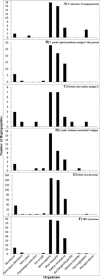Lack of Molecular Mimicry between Nonhuman Primates and Infectious Pathogens: The Possible Genetic Bases
- PMID: 33748822
- PMCID: PMC7964256
- DOI: 10.1055/s-0041-1724106
Lack of Molecular Mimicry between Nonhuman Primates and Infectious Pathogens: The Possible Genetic Bases
Abstract
Recently, it was found that proteomes from poliovirus, measles virus, dengue virus, and severe acute respiratory syndrome-related Coronavirus 2 (SARS-CoV-2) have high molecular mimicry at the heptapeptide level with the human proteome, while heptapeptide commonality is minimal or absent with proteomes from nonhuman primates, that is, gorilla, chimpanzee, and rhesus macaque. To acquire more data on the issue, analyses here have been expanded to Ebola virus, Francisella tularensis , human immunodeficiency virus-1 (HIV-1), Toxoplasma gondii , Variola virus, and Yersinia pestis . Results confirm that heptapeptide overlap is high between pathogens and Homo sapiens , but not between pathogens and primates. Data are discussed in light of the possible genetic bases that differently model primate phenomes, thus possibly underlying the zero/low level of molecular mimicry between infectious agents and primates. Notably, this study might help address preclinical vaccine tests that currently utilize primates as animal models, since autoimmune cross-reactions and the consequent adverse events cannot occur in absentia of shared sequences.
Keywords: autoimmunity; cross-reactivity; infectious agents; molecular mimicry; nonhuman primates; peptide sharing; preclinical test; rhesus macaque; vaccines.
The Author(s). This is an open access article published by Thieme under the terms of the Creative Commons Attribution License, permitting unrestricted use, distribution, and reproduction so long as the original work is properly cited. ( https://creativecommons.org/licenses/by/4.0/ ).
Conflict of interest statement
Conflict of Interest None declared.
Figures

Similar articles
-
Medical, Genomic, and Evolutionary Aspects of the Peptide Sharing between Pathogens, Primates, and Humans.Glob Med Genet. 2020 Aug;7(2):64-67. doi: 10.1055/s-0040-1716334. Epub 2020 Aug 31. Glob Med Genet. 2020. PMID: 32939517 Free PMC article.
-
SARS-CoV-2-Induced Immunosuppression: A Molecular Mimicry Syndrome.Glob Med Genet. 2022 Jul 14;9(3):191-199. doi: 10.1055/s-0042-1748170. eCollection 2022 Sep. Glob Med Genet. 2022. PMID: 35846107 Free PMC article.
-
The chimpanzee and other non-human-primate models in HIV-1 vaccine research.Trends Microbiol. 2000 Sep;8(9):426-31. doi: 10.1016/s0966-842x(00)01816-3. Trends Microbiol. 2000. PMID: 10989311 Review.
-
HIV-1 Cross-Reactive Primary Virus Neutralizing Antibody Response Elicited by Immunization in Nonhuman Primates.J Virol. 2017 Oct 13;91(21):e00910-17. doi: 10.1128/JVI.00910-17. Print 2017 Nov 1. J Virol. 2017. PMID: 28835491 Free PMC article.
-
The roles of nonhuman primates in the preclinical evaluation of candidate AIDS vaccines.Expert Rev Vaccines. 2004 Aug;3(4 Suppl):S5-32. doi: 10.1586/14760584.3.4.s5. Expert Rev Vaccines. 2004. PMID: 15285703 Review.
Cited by
-
From Genetics to Epigenetics: Top 4 Aspects for Improved SARS-CoV-2 Vaccine Designs as Paradigmatic Examples.Glob Med Genet. 2021 Nov 9;9(1):14-17. doi: 10.1055/s-0041-1739495. eCollection 2022 Mar. Glob Med Genet. 2021. PMID: 35169778 Free PMC article. Review.
References
-
- Natale C, Giannini T, Lucchese A, Kanduc D. Computer-assisted analysis of molecular mimicry between human papillomavirus 16 E7 oncoprotein and human protein sequences. Immunol Cell Biol. 2000;78(06):580–585. - PubMed
-
- Lucchese G, Kanduc D. Zika virus and autoimmunity: from microcephaly to Guillain-Barré syndrome, and beyond. Autoimmun Rev. 2016;15(08):801–808. - PubMed
-
- Kanduc D, Shoenfeld Y. Inter-pathogen peptide sharing and the original antigenic sin: Solving a paradox. Open Immunol J. 2018;8:11–27.
LinkOut - more resources
Full Text Sources
Other Literature Sources
Miscellaneous

